pen mill
pen mill
Very old flour mill site, later Chudleigh's Mills
Pen Mill was one of the two Yeovil mills mentioned in the Domesday Book of 1086 - a mill valued at five shillings which was almost certainly the predecessor of Pen Mill. In 1255 the Feet of Fines recorded "Roger atte Penmalne" and in 1337 a reference was made to "William de Penmull".
The 1589 Terrier refers to ".... on the north side of Penmill.... " and the 1633 Survey of Kingston-juxta-Evill recorded that Agnes Jennings leased Pen Mill for a year from 24 June 1634 for an annual rent of £40, payable quarterly.
A lease, dated 29 September 1686, by the Hon. Edward Lord Stourton of Stourton, Wiltshire to Hugh Hasnott of Trent, gent, "of a moiety of a water grist mill and maltmill known as Penn Mill with lands in Yeovil".
In 1699 Rev Martin Strong recorded in his ‘commonplace book’ (see Gallery below) in which he complains of not receiving his due tithes "Mr Harbin pretends a Custom of paying 3s per annum for Penmill, But is no doubt a wrong custom too, he was wont to pay". This reference to 'Mr Harbin' would have been William Harbin (1654-1705), who left the mill "whereof I lately purchased of the Lord Stourton" to his four daughters in his will of 1705. On 20 December 1706 Pen Mill was sold by by Anne, Elizabeth, Frances and Katherine, the spinster daughters of William Harbin to their brother Wyndham Harbin (1) (1685-1740), who had already inherited the Newton Surmaville estate from his father.
On 5 March 1771 Wyndham Harbin (1)'s son Swayne Harbin (1718-1781) of Newton Surmaville, Esq. leased to miller Samuel Trent of Ilchester "a messuage and lands known as Penn Mill, Yeovil." It was leased to Samuel Trent again in 1793 by Swayne's son, Wyndham Harbin.
In 1801 "Robert Tytherleigh of Pen Mills, Yeovil, miller" was party to a lease of Windmill Hill (today's Wyndham Hill).
In the 7 July 1814 edition of the Taunton Courier and Western Advertiser noted the sale to be held at the Fleur de Lys Inn, Yeovil, of "A very superior Corn Mill called Pen Mill, working three pair of stones capable of grinding 1,000 bushels of corn a week, with the machinery thereto belonging, together with the Dwelling House, Bake house, Stables, Outhouses, Yard, Gardens and Orchard thereto adjoining, containing about two acres, situate in the parish of Yeovil, and now in the possession of Mr Samuel Trent, a Bankrupt. The Premises constitute a most desirable property, are in excellent repair, well established as a Corn Mill, situated in a very populous neighbourhood, peculiarly convenient as to markets, and require only to be viewed to be duly appreciated."
In 1827, Robert Allen was recorded as the miller at Pen Mill in the 'Return of men qualified to serve on Juries'. In an agreement dated 10 March 1832, Wyndham Harbin let the mill to "Robert Allen of Penmill, miller" and Allen was also listed as a miller in the Somerset Gazette Directory of 1840. In the 1846 Tithe Apportionment it was noted that Pen Mill, Garden and Orchard (Parcel 859) and Yeovil Bridge Mead (Parcel 860) were owned by George Harbin of Newton House and occupied by Robert Allen. In his will of 1848, Robert Allen refers to himself as the miller of Pen Mill.
Whitby's Yeovil Almanack Advertiser of 1882 listed George Marden as the Miller, Pen Mill.
On 1 September 1892 Elizabeth Harbin of Newton Surmaville leased "to Albert Ben Marsh of Pen Mill, Yeovil, miller, of Pen Mills, Yeovil, for the term of fourteen years". The 1892 to 1903 editions of Whitby's noted that Albert Ben Marsh was Miller of Pen Mills.
W White was listed as the Manager, Pen Mills, in Collins' Directory of 1907.
In July 1948 the Ministry of Town and Country Planning, in its Provisional List of Buildings of Architectural or Historic Interest in Yeovil Municipal Borough, recorded Pen Mill as a Grade III Listed Building with the following description "It is probable that this is a very old mill site. The mill building and part of the Mill House are 17th century or earlier. The latter retains original beams and some 17th century, or early 18th, stone mullioned windows with lead glazing. The west end of the house was added early or mid-19th century. The Mill building has recently lost its stone slate (sic: tile) roof. Water wheel removed. All mill buildings are listed except the westernmost range at right-angles to road, which is more recent."
By the time of Snell's Directory of 1954-5, B Chudleigh & Sons were listed in the Millers & Corn Merchants section as being of Hendford and Pen Mills as well as Gawbridge Mills, Martock. Foord's Directory of 1964-5 listed Jack Frederick Chudleigh and in 1974 Kelly's Directory listed DR Chudleigh.
The following description is from the Somerset Historic Environment Record of 1977 -
The main sluices across the River Yeo are modern and maintained for river control. The mill building is unexceptional, built mainly of local stone with many recent additions. The wheel pit, over which part of the mill is built, is large. The external wall is massive and built onto the bed rock of the river. Three stones each about 18" by 24" built into the pits internal walls and have deeply carved identical designs. In the outer wall is the stone lintel on which the wheel bearing was fixed, originally had either a high or mid breast wheel approximately 16ft diameter and 8ft wide. None of the mill machinery remains. At the bottom, upstream, end of the wheel pit there are the partly submerged remains of the casting of a large vortex turbine together with sluice value, and the screw opening mechanism on the ground floor. There is a name plate on the value on which the name "Thompson" is visible. The metal seating and iron support pillars for two pairs of 4ft diameter stones driven by this turbine remain. Also one short section of long shaft with two pulley wheels.
gallery

An extract of 1699 from the ‘commonplace book’ of Rev Martin Strong in which he complains of not receiving his due tithes - this entry reads "Mr Harbin pretends a Custom of paying 3s per annum for Penmill, But is no doubt a wrong custom too, he was wont to pay".
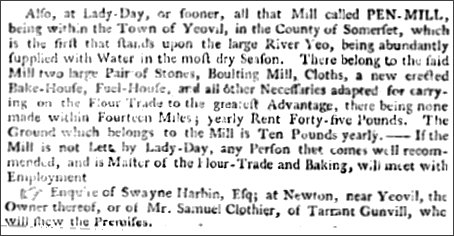
A notice place in the Salisbury & Winchester Journal, 18 February 1751. The value of the £45 annual rent at today's value is about £6,500.
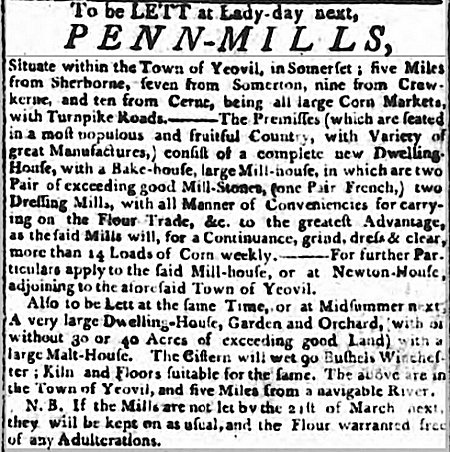
Sherborne Mercury, 26 February 1770
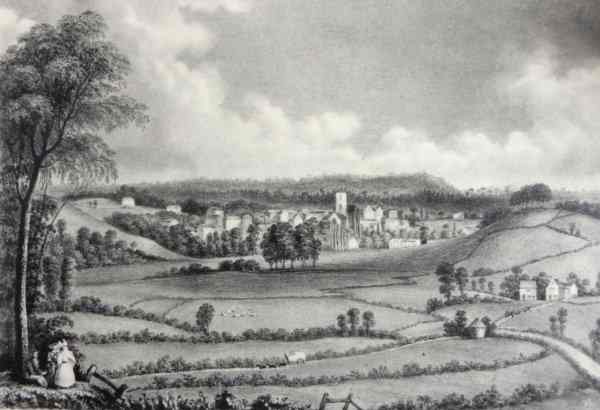
Courtesy of Dave
Shorey
Yeovil seen from Babylon Hill in the late 18th century from a lithograph by T Jerome. Penn Hill is seen at left, surmounted by Penn House, and Wyndham Hill is seen at right with the buildings of Pen Mill at its foot.
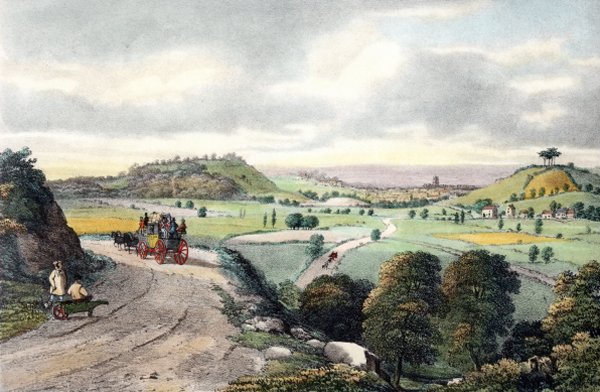
From my
collection
'View of Yeovil from Babylon Hill' in a stone lithograph by Henry Burn (c1807-1884) and published by William Porter and Henry Marsh Custard in 1839. With Summerhouse Hill at left, with Penn Hill behind it, surmounted by Penn House, and Wyndham Hill at right. The buildings at Pen Mill are seen at the base of the latter, with the tower of St John's church above and to the left. At centre, a coach is seen on the Sherborne Road before it was re-aligned.
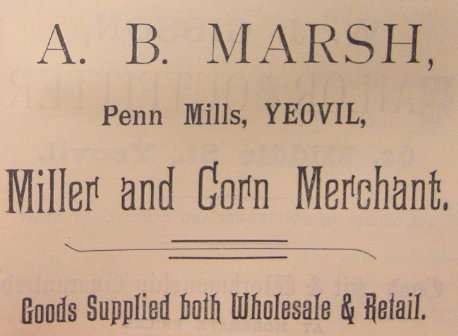
An advertisement in Whitby's Yeovil Almanack Advertiser of 1892 placed by Albert Marsh.
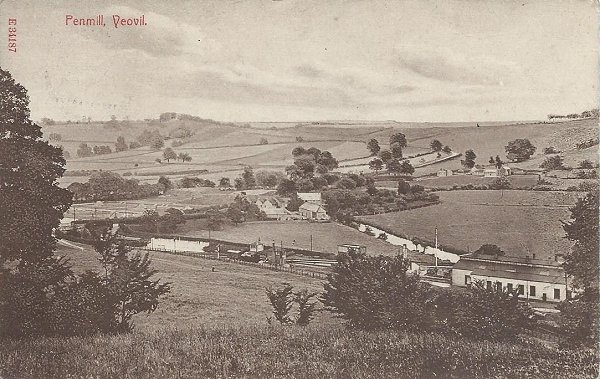
From my
collection
-
This photograph
features in my
book 'Yeovil
From Old
Photographs'
A postcard of about 1910 looking southeast and showing Pen Mill at centre. At bottom right is the Pen Mill Station engine shed and the signal box just below and to the left of the mill at centre. Between the engine shed and the mill is the mill stream and the Sherborne Road runs from just above centre left to the mill. Pen Mill Station is off image to the left.
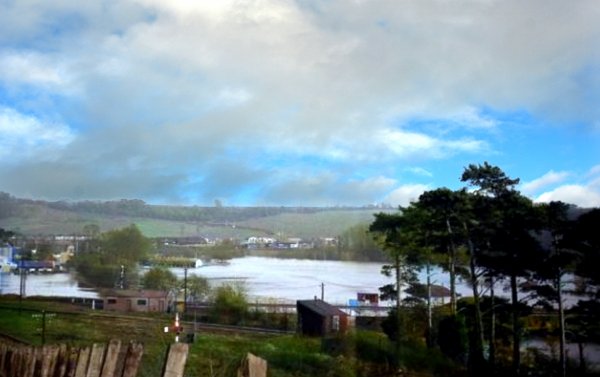
Courtesy of
Richard
Parkhouse
Flood water at Chudleigh’s Mill, taken from the lower end of Wyndham Hill, with the area of the former Yeovil Pen Mill engine shed in the foreground between the lines to Weymouth and the Taunton branch. A colourised photograph of early 1966.
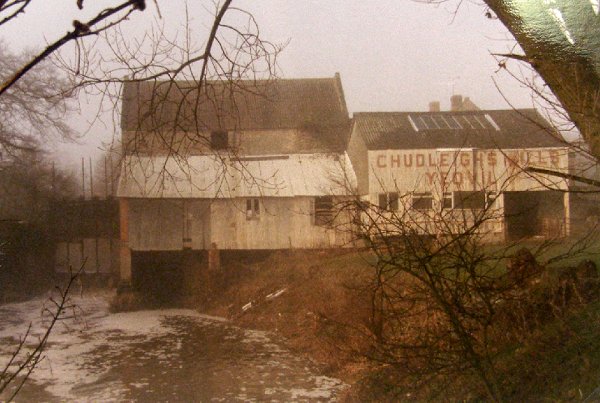
This
photograph
features in my
book "Lost Yeovil"
Penn Mill, by the time of this 1970's photograph known as Chudleigh's Mills.
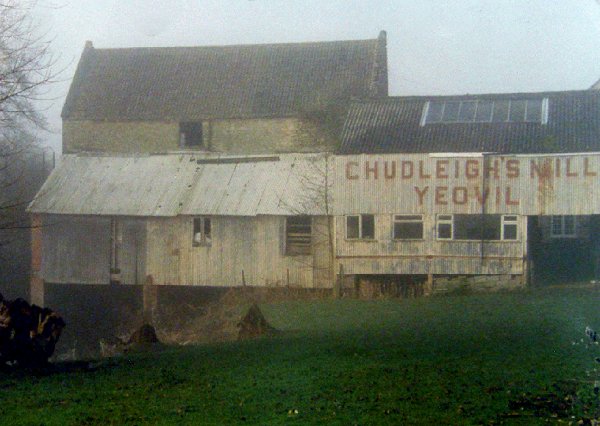
Chudleigh's Mills, again photographed in the 1970s.
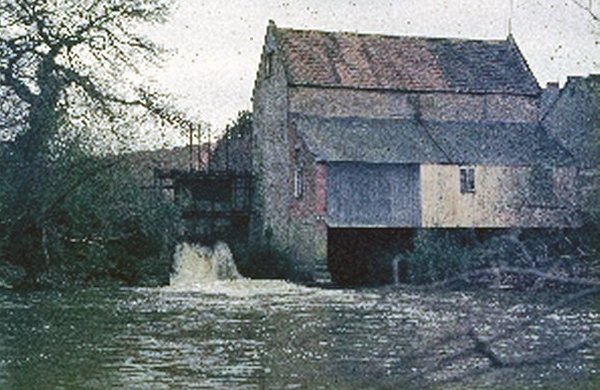
.... and a very grainy photograph from the 1980s.
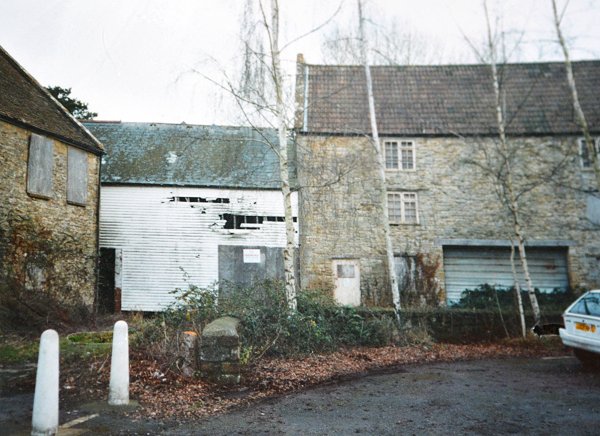
The mill buildings seen from the other side, photographed in the 1990s.
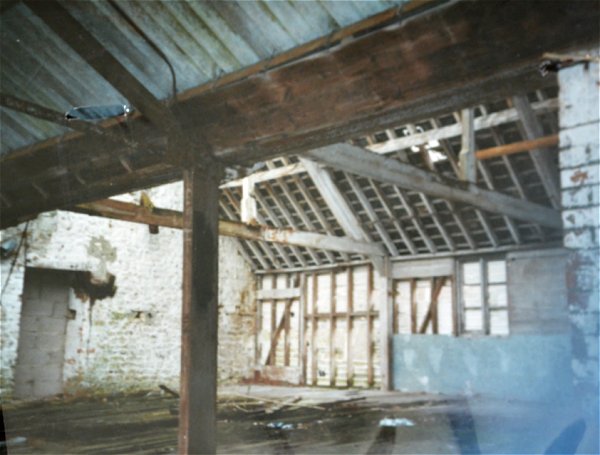
Interior photograph of the roof-space in the mill building, photographed in the 1990s.
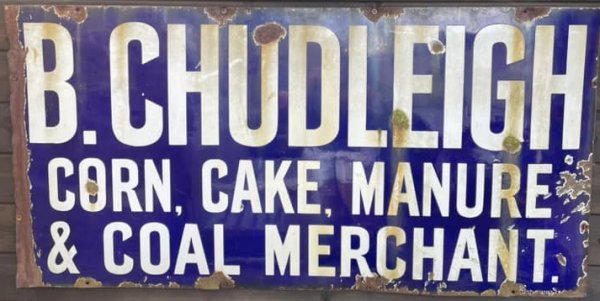
Courtesy of Mark
Chudleigh
A 1950s enamelled sign of B Chudleigh & Sons of Hendford and Pen Mills.
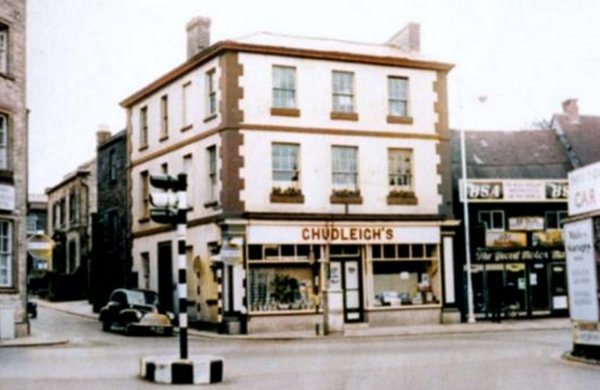
This
colourised photograph
features in my
book "Lost Yeovil"
This photograph, probably taken in the 1960's, shows how narrow South Street (with the car driving out of it) was at the time. The Three Choughs Hotel is at left. Chudleigh's Seed Merchants was demolished in the 1960's to widen South Street.
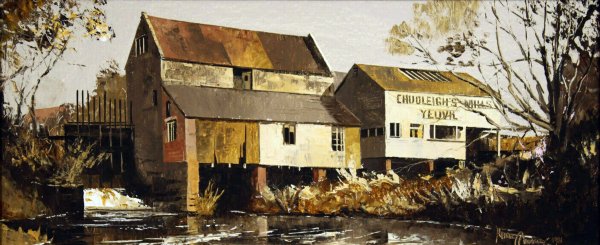
Chudleigh's Mill - a pallet knife oil painting by local artist, the late Harley Crossley.
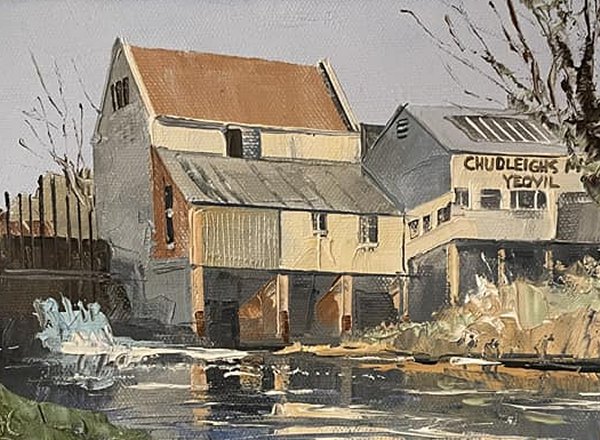
Courtesy of Mark
Chudleigh
Another painting of Chudleigh's Mill.
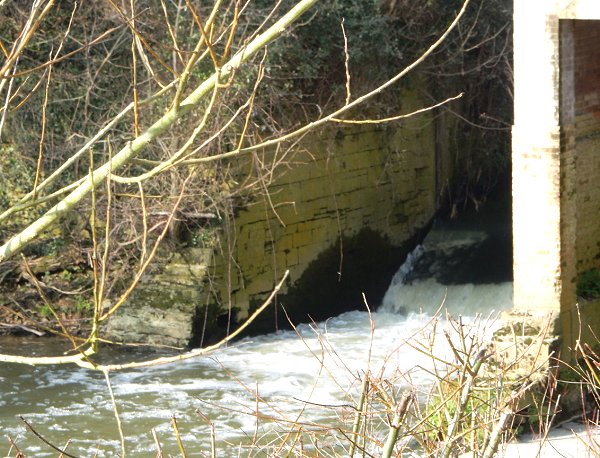
The mill race survives even though the water wheel went years ago. Photographed in 2016.